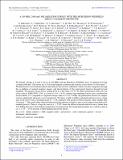A 189 MHz, 2400 Deg[superscript 2] POLARIZATION SURVEY WITH THE MURCHISON WIDEFIELD ARRAY 32-ELEMENT PROTOTYPE
Author(s)
Williams, Christopher Leigh; Goeke, Robert F.; Hewitt, Jacqueline N.; Morgan, Edward H.; Remillard, Ronald Alan; Cappallo, Roger J.; Corey, Brian E.; Kincaid, Barton B.; Kratzenberg, Eric W.; Lonsdale, Colin John; McWhirter, Stephen R.; Rogers, Alan E. E.; Salah, J. E.; Whitney, Alan R.; ... Show more Show less
DownloadBernardi-2013-A 189 MHz, 2400 Deg2.pdf (2.840Mb)
PUBLISHER_POLICY
Publisher Policy
Article is made available in accordance with the publisher's policy and may be subject to US copyright law. Please refer to the publisher's site for terms of use.
Terms of use
Metadata
Show full item recordAbstract
We present a Stokes I, Q and U survey at 189 MHz with the Murchison Widefield Array 32 element prototype covering 2400 deg[superscript 2]. The survey has a 15.6 arcmin angular resolution and achieves a noise level of 15 mJy beam[superscript –1]. We demonstrate a novel interferometric data analysis that involves calibration of drift scan data, integration through the co-addition of warped snapshot images, and deconvolution of the point-spread function through forward modeling. We present a point source catalog down to a flux limit of 4 Jy. We detect polarization from only one of the sources, PMN J0351-2744, at a level of 1.8% ± 0.4%, whereas the remaining sources have a polarization fraction below 2%. Compared to a reported average value of 7% at 1.4 GHz, the polarization fraction of compact sources significantly decreases at low frequencies. We find a wealth of diffuse polarized emission across a large area of the survey with a maximum peak of ~13 K, primarily with positive rotation measure values smaller than +10 rad m[superscript –2]. The small values observed indicate that the emission is likely to have a local origin (closer than a few hundred parsecs). There is a large sky area at α ≥ 2[superscript h]30[superscript m] where the diffuse polarized emission rms is fainter than 1 K. Within this area of low Galactic polarization we characterize the foreground properties in a cold sky patch at (α, δ) = (4[superscript h], –27[° over .]6) in terms of three-dimensional power spectra.
Date issued
2013-06Department
Haystack Observatory; MIT Kavli Institute for Astrophysics and Space ResearchJournal
The Astrophysical Journal
Publisher
IOP Publishing
Citation
Bernardi, G., L. J. Greenhill, D. A. Mitchell, S. M. Ord, B. J. Hazelton, B. M. Gaensler, A. de Oliveira-Costa, et al. “A 189 MHz, 2400 Deg[superscript 2] POLARIZATION SURVEY WITH THE MURCHISON WIDEFIELD ARRAY 32-ELEMENT PROTOTYPE.” The Astrophysical Journal 771, no. 2 (June 24, 2013): 105. © 2013 The American Astronomical Society
Version: Final published version
ISSN
0004-637X
1538-4357